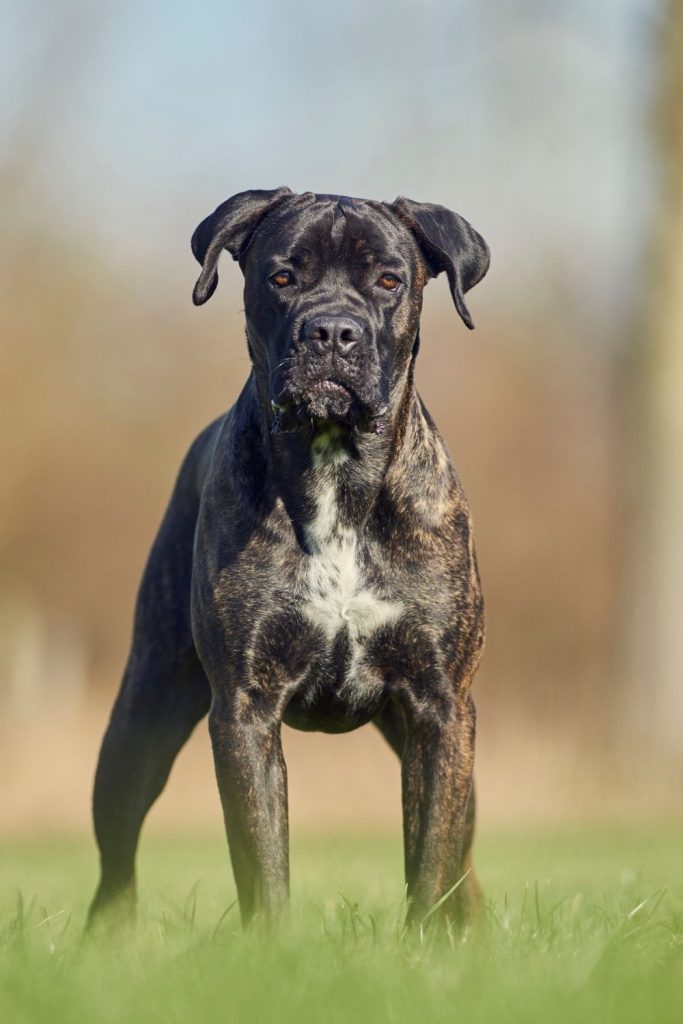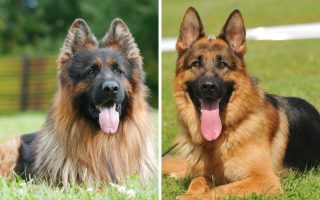Top on the list of great companion and guard dogs is the Cane Corso.
Its powerful appearance and build mark it as a valued protector to have around.
Aside from its temperament and behavior, the Cane Corso colors are another important factor to consider when getting a puppy.
The American Kennel Club (AKC) stipulates that the acceptable coat colors for the Cane Corso breed are red, black, light and darker shades of gray, and light and darker shades of fawn. [1]
Brindled variants are also permitted alongside variants with dark-colored masks centered around their eyes.
White color patches likewise conform to the breed standard but tanned color spots are a no-no.
Other than influencing their appearance, researchers have established a link between congenital health issues and some of Cane Corso’s coat colors. [2]
Some shades lead to dreadful health complications later in life as well as reduce the affected Corso’s life span.
This is exactly why you need to pay extra care to the purchase process.
Frankly, if you would like to have your Corso around for a long time, we would advise that you get a black brindle variant.
In 2017, the Open Veterinary Journal published a research study affirming that the median life expectancy of black brindle dogs (not limited to Cane Corso) surpassed the expectancy of all dogs by 1.01 years, and exceeded the average expectancy of all other colored dogs by 2.21 years. [3]
The Best Cane Corso Colors Acceptable By Kennel Clubs
According to the set standards of the AKC and the Fédération Cynologique Internationale (FCI), there are six basic acceptable coat colors/color patterns for a Corso: [1][4]
- Black
- Gray
- Brindle
- Red or fawn (black mask)
- Chestnut
- Formentino (gray mask)
Red-colored Corsos may have black masks, even gray, but those should never extend beyond the eyes.
The same goes with the solid fawn coat variety.
Let’s review the basic Corso coat colors you need to know and what each holds:
1. Black Cane Corso

Most folks won’t admit this but they prefer the black Cane Corso color variants for the simple reason that they seem more menacing.
Black variants have the eumelanin pigment to thank for their distinctive appearance. [5]
Generally, eumelanin in Cane Corsos aren’t homozygous and as such, you rarely find other color specks on their solid black coats.
However, black Corsos tend to have issues with their coats. For one, they tend to have more airy undercoats compared with brindles or fawns.
For another, most owners affirm that their coats are always too oily and shorter than observed with brindles and fawn.
It’s easy to explain their peculiarities when you consider the fact that black substances are better at absorbing the sun’s electromagnetic rays.
As such, solid black Cane Corsos will definitely come off as warmer than fawn dogs and brindles causing them to overheat and incur bodily mechanisms to cool down.
2. Grey Cane Corso

The Cane Corso happens to be the only Molosser breed with gray color variants. That singular distinction makes them invaluable to many. [11]
Improper formation of eumelanin which results from the recessive dilute gene leads to the gray color. [5]
For the tone to manifest, they must have received the dilute gene from not one but both parents.
Gray Corso pups do not often retain the same color shade with time.
Either they lighten or they grow shades darker upon the dual influence of maturity and continual exposure to sunlight.
3. Fawn Cane Corso

Fawns are by far the most common color variant of the Cane Corso breed.
Fortunately, the variant conforms to the AKC breed standards and runs virtually zero chances of developing genetically related health complications later in life.
With this color variant, it’s essential that their masks are either black or gray and cover only their eyes.
White patches on the throat, chin, or chest all conform to club standards and are equally all acceptable.
We think you ought to note that you can find their color tones in different degrees of saturation i.e. from light cream to dark tan.
4. Red Cane Corso

Most red Cane Corsos usually have black or gray masks, but as a whole, they are not as common as the fawn variant.
At times, you can equally find red pups with black, even blue saddle marks which eventually fade with maturity.
Red Corsos tend to differ slightly in appearance even among themselves.
Some are paler in color while some tend to take on a shade as deep as mahogany.
While the same genetic material influences the pigment, its degree of dilution differs as such influencing a different shade of pigment.
5. Formentino Cane Corso

Gray masked Corsos with a really light fawn overlay are regarded as “formentino”.
Formentino pups usually receive a red/fawn gene from each parent. Combined with a dilute gene, you find that their masks are grey.
The formentino coats are one of the rare Cane Corso colors you would ever find though.
6. Brindle Cane Corso
Corsos with Brindle color patterns has other colors splashed on top of their base color which could be fawn or red.
Typical variations of the Cane Corso brindle colors include:
- Black Brindle
- Gray Brindle
- Reverse Black Brindle
- Chestnut Brindle
With the gray brindle variant and likewise the reverse grey brindle, the offspring must have received the dilute recessive gene from one parent in addition to the dominant fawn or red gene for their base color from the other parent.
Reverse brindles usually have lighter color overlays (i.e brindles) which rather than darken the overlay region, instead lighten it.
As such, a reverse black brindle Corso with a fawn base color could have its coat resemble a tiger’s.
Worthy of note is that researchers can’t really explain what leads to the degree of brindle on a Corso and whether or not an offspring will come off as straight brindle or reverse brindle cannot really be predetermined.
6.1. Black Brindle

Black brindle Cane Corsos have red or fawn base colors overlaid with black stripes.
This is totally normal and doesn’t imply any genetic defects.
Their vague resemblance with striped tiger coats has earned them the “tiger stripes” nickname.
6.2. Grey Brindle

Grey brindle variants equally have a fawn or red base color like their black brindle brothers with grey overlays.
They are not as common as black brindles though.
6.3. Chestnut Brindle

These variants are rare and for every 20 other color variants, only one is a chestnut brindle Cane Corso.
They have saturated reddish-brown overlays on a red or brown base.
Rare Cane Corso Coat Colors
The color variants examined in this section are not officially recognized under either the AKC’s or FCI’s breed standard.
Their scarcity drives their demand high. As such, you might come across some backyard breeders who unethically breed these color variants for their high retail value.
Such breeders often claim that these variants are uncommon and have no underlying health conditions.
However, multiple research studies have established over and over the positive correlation between the recessive gene responsible for their odd pigmentation and underlying health complications.
So, let’s review some of the uncommon variants you might find:
Blue Cane Corso

The two breed standards make no mention of blue Corsos. Yet, some breeders often put up “blue” pups for sale.
This, to no small extent, generates a great deal of confusion among concerned parties.
Fact is, gray Cane Corsos with their pigment so diluted it seems dark blue are termed as such.
That is, whereas the breed standards regard them as gray, most breeders loosely term them “blue”.
Worthy of note is that the recessive gene responsible for their odd pigmentation predisposes them to more serious underlying skin problems such as mange and the Color Dilution Alopecia (CDA). [12][13]
Liver/Chocolate Cane Corso

If you find the chocolate Cane Corso attractive in appearance, trust us, you are only one of a long-standing line of admirers.
In spite of this, the kennel clubs clamp down firmly on their breeding.
There are regulations in place with the government to bar them from being registered or licensed on the basis of the health conditions they tend to face later in life.
At first glance, they may look like the red Cane Corso but the absence of a black mask checks the thought.
These color variants tend to be mostly unhealthy and suffer from a range of health conditions such as eye deformity, pyotraumatic dermatitis, etc.
Given that they are guaranteed to burn you a whole lot of cash in future medical expenses, we think you ought to overlook them.
If you do insist on purchasing this coat variant, you shouldn’t pay more than you would for the more common variants.
Isabella Cane Corso

The tawny or isabella Cane Corsos have a coat with a dilute shade of the chocolate variant.
In place of a black mask, their eyes and nose take on a purplish tone instead.
Both the AKC and the FCI frown on their breeding as they tend to suffer from the health afflictions affecting other breeds bred for color.
Cane Corso Coat Genetics
Whole textbooks’ chapters have been devoted to the study of canine genetics.
As such, a complete treatment of the topic would necessitate a whole blog post.
As you most likely do not have that much interest in the topic, we’ll try to give you a rundown.
Firstly, two types of pigments decide your Cane Corso coat color: the eumelanin and the pheomelanin.
For every individual Corso, their eumelanin and pheomelanin have default color codes decided by the genes from their direct parents.
As the eumelanin’s default hue is black, different concentrations of it can only result in brown and grey. Note that most breeders tend to tag grey dogs as blue.
On the side, the modification of pheomelanin results in orange, red, cream, and gold.
The extent of the dilution of the gene responsible for the pigment determines its shade.
Another crucial point to note about the pigments; pheomelanin influences only a Corso’s coat color while eumelanin influences the Corso’s coat, eyes, and nose masks.
Does Coat Color Affect Cane Corso’s Health & Behavior?
Based on available research, we can conclusively state that the Cane Corso’s coat has little influence on its behavior.
But with its health, that’s a whole different sphere entirely.
As we mentioned earlier, certain coat colors tend to have different health issues attached to the pups.
Doing the proper research often marks the difference between a healthy dog with a proper lifespan and another that burns your cash in medical expenses.
It’s essential you rummage through the internet for breed standards enacted by kennel clubs and organizations alike before making your purchase.
Explained below are some of the more common health complications experienced by dogs bred for color:
- Deafness: A gene linked to the pigmentation for some dogs (merle-colored dogs, for instance) often causes an intense ear infection which leads to hearing loss if left untreated.
- Eye-Deformities: Chocolate, Formentino, and Isabella variants run the risk of developing conjunctiva deformities such as microphthalmia and anisocoria, which ultimately causes blindness if left untreated. [6]
- Sunburn: Lack of proper skin pigmentation causes sunburn. A familiar example is with albinos. If left unattended, sunburn eventually leads to skin infections which could eventually worsen into cancer.
Corsos run the risk of contracting three types of cancer: squamous cell carcinoma, mast cell tumors, and malignant melanoma. [7][8][9]
- Color Dilution Alopecia: Isabella fawns carry a recessive gene that causes hair loss and skin rashes.
- Pyotraumatic Dermatitis: This condition leads to the development of plaque-like lesions on the skin.
If left unattended to, it might eventually cause a dog’s hair to mat or crust. Mostly, liver-coated pups suffer from this condition.
- Black Hair Follicular Dysplasia: Dogs that develop this condition lose their hair, contract skin infections, have a reduced coat quality and eventually develop dry and scaly skin.
Chocolate, liver or black coat dogs run the highest risk of developing this condition.
- Otitis Externa: This defect causes the external ear canal of a Corso to get inflamed. This usually afflicts chocolate-colored Corsos.
Cane Corso Eye and Nose Colors
You should expect your pup’s iris to be similar in color to the darkest region of his coat.
For instance, with a solid black Corso, the Iris color should be a dark shade of hazel.
The rule of thumb is that the darker your pooch’s coat, the darker would be the coloration of his iris.
The AKC goes further and demands that black-masked dogs with brown/red or black coats should have amber-colored eyes while gray-masked dogs can have lighter shades.
On the side though, the FCI recognizes that this is inapplicable to Corso with dilute genes as they can have only light-colored eyes.
To minimize the chances of your Corso developing eye defects later in life, it’s important that their Iris colors never be lighter than a light hazel.
Worthy of note is that, other than their coat, your Corso’s nose and eye rim pigmentation to an extent influence the Iris color also.
Regarding the Cane Corso nose colors, AKC regulations demand that it matches your pooch’s coat i.e. black-coated dogs should have a black nose.
In the same vein, gray-coated dogs should have gray-colored noses. [10]
Disqualifying Eye Colors
The AKC breed standard disqualifies a Cane Corso with blue or yellow eyes from being registered or bred for offspring.
These variants indicate improper development, genetic fault, and a deficiency of coloration.
In some scenarios, some pups do start life off with blue eyes especially if they host dilute genes.
Prolonged exposure to sunlight influences their natural change with time.
Blue eyes may look cute but considering the health implications attached, you should hope that their eyes never remain blue.
Does Color Really Matter for the Cane Corso?

Yes. While the coat color has zero influence on your pup’s temperament, the influence of the wrong color choice on your dog’s health cannot be overemphasized.
As we explained earlier, the genes attributed to some color shades likewise are responsible for some health complications a Cane Corso might develop.
One of the most popular studies affirming this correlation was published on ScienceDaily by the University of Sydney in 2004. [2]
The same study also showed that chocolate-colored Corso is more prone to getting obese, developing joint aches, and contracting ear infections.
In a BAER test performed by a prominent researcher George Strain of Louisiana State University in Baton Rouge featuring 11,000 canines, test results indicated that a Cane Corso with piebald and merle-colored coats ran a greater risk of eventually going deaf. [14][15]
It pays to be aware of the inherent health complications associated with a dog’s coat color.
Purchasing unhealthy pups from nonchalant breeders is sure to lead to a lot of cash burn at the vets in the future.
Frequently Asked Questions
What is the rarest Cane Corso color?
The rarest Cane Corso color tends to be either Isabella, chocolate/liver, or formentino.
They occur infrequently compared with the standardized ones by kennel clubs as they are influenced by recessive genes.
What is the most common Cane Corso color?
The most frequent coat color of the Cane Corso dog breed is black.
Is there a white Cane Corso?
There are no white Cane Corsos. Some people merely mistake the formentino color variant as a white Cane Corso.
However, any member of this breed may have white underlying patches anywhere on their coats.
Do Cane Corso puppies change color as they grow?
Cane Corso puppies tend to start off as blue-eyed in their early days and eventually adjust over time to their permanent eye colors, usually brown.
At birth, most puppies haven’t started producing melanin and as such, they start off with blue eyes.
As soon as the Iris gets progressively exposed to sunlight, the Iris traps the rays inducing greater melanin production.
It’s common and normal with most dog breeds, not just the Cane Corso, for their puppies to change eye color with time.
Final Thoughts
We’ve treated the rarest and the most frequent Cane Corso colors. It’s up to you to decide on which coat variant best suits you.
Each coat color is distinctive in its own way and reflects the best the breed has to offer you.
While the Corso might be a noble, loyal to a fault breed, it’s essential you are firm with their training to forge them into the well-mannered companion you want them to be.
Remember, with a breed the size and temperament of the Corso, socialization is key to getting them to be everybody’s best friend.
You May Also Like:
20 Most Dangerous Dog Breeds You Mustn’t Mess With
References & Notes:
- AKC: “Cane Corso Dog Breed Information.”
- ScienceDaily: “A dog’s color could impact longevity, increase health issues.”
- Open Veterinary Journal: “Longevity of Cane Corso Italiano dog breed and its relationship with hair colour.”
- FCI (12/17/2015): “Italian Cane Corso FCI-Standard N° 343.”
- VCA Animal Hospitals: “Genetics Basics: Coat Color Genetics in Dogs.”
- Wag!: “Microphthalmia and Ocular Dysgenesis in Dogs.”
- PetMD: “Skin Cancer (Squamous Cell Carcinoma) in Dogs.”
- PennVet: “Mast Cell Tumors in Dogs.”
- Metropolitan Veterinary Associates: “What Is Canine Melanoma?”
- AKC (October 20, 2009): “Official Standard of the Cane Corso.”
- Modern Molosser (11/15/2016): “The Cane Corso Coat.”
- AKC (Jan 23, 2019): “Mange in Dogs: What You Need to Know.”
- Wag!: “Color Dilution Alopecia in Dogs.”
- The University of Sydney: “BAER Testing.”
- PsychologyToday (July 10, 2012): “Your Dog’s Coat Color Predicts His Hearing Ability.”
- BMC Genomic Data (04 March 2019): “Inheritance of coat colour in the cane Corso Italiano dog.”







